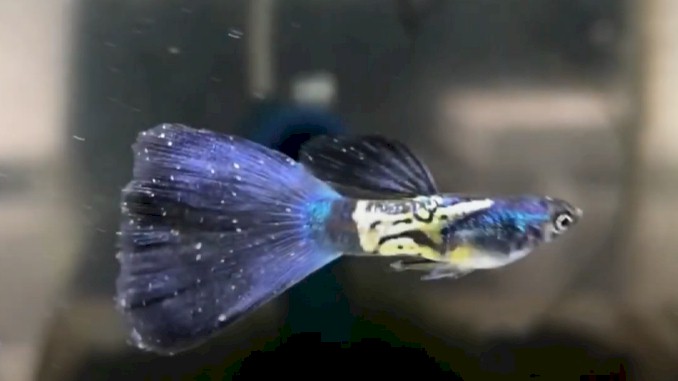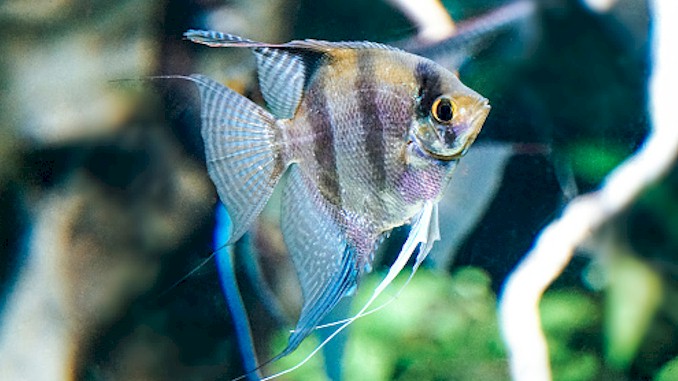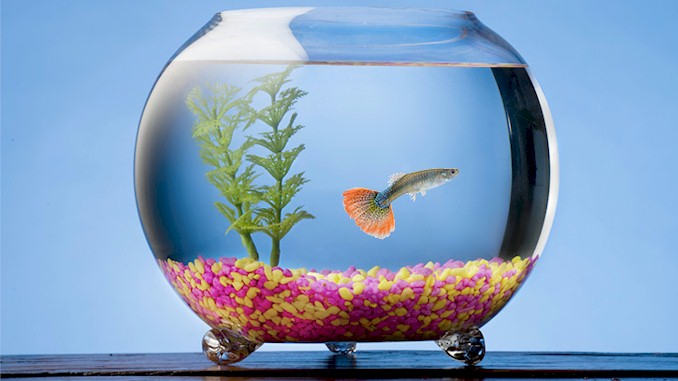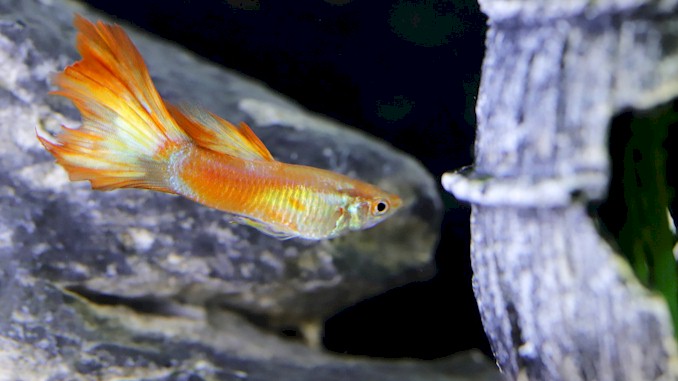Why Are My Guppies Turning Black (With Solutions)
A few weeks ago, I welcomed six new guppies into my aquarium. They seemed to be thriving until I noticed a concerning change in one of them. The female guppy’s once-vibrant colors began to darken and turn black. Worried and unsure of what was happening, I took to Google in search of answers. After extensive research, I discovered some essential information on why guppies turn black and how to prevent it from happening again. Here is what I have learned:
Guppies turn black for various reasons, such as aggression, infection, stress, or genetics. Aggression causes guppies to blacken their eyes to intimidate other fish. Infection by viruses, parasites, or bacteria can cause black spots or patches on the guppy’s body or tail. Stress from overcrowding, poor water quality, or predators can also trigger blackening. Genetics can influence the coloration of guppies, especially if they are selectively bred for certain traits.
Now that you know the possible causes of guppies turning black, you may wonder how to prevent and treat this condition. Don’t worry, I have you covered. In the following sections, I will share with you some tips and tricks on how to keep your guppies healthy and happy. You will also learn how to identify and deal with common guppy diseases and parasites. So, stay tuned and keep reading. You don’t want to miss this valuable information.
Genetics: Understanding how genetics can influence the coloration of your guppies.
First, let’s talk about the genetics of guppies and how they would cause your guppies to turn black.
Guppy coloration can be attributed to their genetics, with specific genes responsible for determining their color patterns. It’s essential to understand these genes to identify the color patterns of your guppies and predict the color of their offspring. The inheritance of these genes can be complicated and involve multiple factors, such as incomplete dominance, co-dominance, and sex-linked traits.
Incomplete dominance occurs when neither of the two genes is completely dominant over the other, resulting in a blend of the two colors. For example, if a blue guppy and a yellow guppy are bred, their offspring will be green, which is a blend of the two colors.
Co-dominance is when both genes are expressed equally, and neither is dominant over the other. An example of this is when a red guppy and a white guppy are bred, and their offspring is a mix of red and white patches.
Sex-linked traits are specific to the sex of the guppy, and certain color patterns are only expressed in males or females. For example, the Cobra gene is a sex-linked trait that results in a thick, black stripe on the male guppy’s body.
The color patterns of guppies can also be influenced by selective breeding, where breeders select guppies with specific color patterns and breed them to produce offspring with the same traits. This practice can lead to an increase in the frequency of certain genes responsible for desirable color patterns.
As you see, understanding guppy genetics is crucial to predict the coloration of your guppies and breed them selectively. It can also help you identify specific color patterns that may be linked to certain genes and determine whether certain traits are sex-linked. By understanding the basics of guppy genetics, you can create a more diverse and visually appealing aquarium while ensuring the health and well-being of your guppies.
How to Reduce Aggression Among Guppies
One of the possible reasons why your guppies are turning black is aggression. Guppies are generally peaceful and social fish, but they can become aggressive under certain conditions. Aggression can cause stress, injuries, and even death among guppies. Therefore, it is important to understand why guppies become aggressive and how to prevent or stop it.
Why Do Guppies Become Aggressive?
Guppies can become aggressive for various reasons, such as:
- Sexual competition: Male guppies are more aggressive than females, especially when they are competing for mates. Male guppies will chase, nip, and display their fins to impress females and intimidate other males. This can lead to blackening of the eyes, which is a sign of dominance and hierarchy.
- Overcrowding: Guppies need enough space to swim and explore. If the tank is too small or has too many fish, guppies will feel cramped and stressed. This can trigger aggression and territorial behavior, as guppies will try to defend their limited resources and space.
- Food scarcity: Guppies are omnivorous and need a balanced diet of flakes, pellets, live, or frozen foods. If the food is insufficient or not varied, guppies will become hungry and aggressive. They will fight over food and may even resort to cannibalism.
- Lack of hiding spots: Guppies need places to hide and rest, such as plants, rocks, or caves. If the tank is bare or has few decorations, guppies will feel exposed and vulnerable. They will become nervous and aggressive, and may attack other fish or themselves.
- Small group size: Guppies are social fish and need to live in groups of at least five or six. If the group is too small, guppies will feel lonely and insecure. They will become aggressive and may try to join other groups of fish, which can cause conflicts.
How to Prevent or Stop Guppy Aggression?
Guppy aggression can be prevented or stopped by following some simple tips, such as:
- Maintain a proper male to female ratio: The ideal ratio is one male to two or three females. This will reduce the sexual competition and aggression among males, and provide more mating opportunities for them. It will also prevent females from being harassed and stressed by too many males.
- Provide enough space and water quality: The minimum tank size for guppies is 10 gallons, but larger is better. The tank should be well-filtered, aerated, and heated to maintain optimal water quality. The water parameters should be: pH 6.8-7.8, hardness 8-12 dGH, and temperature 75-82°F. The tank should be cleaned and water changed regularly to prevent ammonia buildup, which can cause guppy blackening.
- Offer a varied and sufficient diet: Guppies should be fed twice a day, with a pinch of food that they can finish in two or three minutes. The food should be varied and include flakes, pellets, live, or frozen foods, such as brine shrimp, bloodworms, or daphnia. The food should be high in protein, vitamins, and minerals to keep guppies healthy and colorful.
- Add hiding spots and decorations: The tank should have plenty of plants, rocks, or caves to provide hiding spots and shelter for guppies. This will make them feel more secure and comfortable, and reduce their stress and aggression. The decorations should also be colorful and attractive, to stimulate guppies’ senses and curiosity.
- Keep guppies in a large and compatible group: Guppies should be kept in a group of at least five or six, preferably of the same species or strain. This will ensure that they have enough social interaction and companionship, and prevent them from feeling lonely and aggressive. Guppies should also be compatible with other fish in the tank, such as tetras, mollies, or platies. Avoid keeping guppies with larger or more aggressive fish, such as cichlids, barbs, or bettas, as they can harm or eat guppies.
By following these tips, you can reduce the aggression among your guppies and keep them healthy and happy. Aggression can cause guppies to turn black, but it is not the only reason. In the next section, I will talk about another possible cause of guppy blackening: black spot disease.
How to Recognize and Treat Black Spot Disease
Another possible reason why your guppies are turning black is black spot disease. Black spot disease, also known as fluke disease, is a freshwater fish disease caused by the flatworms larvae. Guppy suffering from black spot disease will develop tiny black spots in their fins, gills, and all over the body. This disease’s life cycle starts from a bird to snail to fish.
Black spot disease can cause stress, discomfort, and damage to your guppies. It can also affect their growth, color, and immunity. Therefore, it is important to recognize and treat black spot disease as soon as possible.
How to Recognize Black Spot Disease?
Black spot disease is easy to recognize by its distinctive symptoms, such as:
- Black spots on the guppy’s body, especially on the fins, gills, and eyes. The spots are actually the cysts of the flatworms, which can vary in size and number.
- Scratching or rubbing against other objects, such as plants, rocks, or gravel. This is a sign of irritation and itching caused by the flatworms.
- Decrease or loss in appetite. Guppies with black spot disease may lose interest in food or eat less than usual.
- Lethargy. Guppies with black spot disease may become less active and swim slowly or rest at the bottom of the tank.
- Faded color. Guppies with black spot disease may lose their vibrant color and become dull or pale.
If you notice any of these symptoms in your guppies, you should act quickly and treat them for black spot disease.
How To Treat Black Spot Disease
Before treating your guppies for black spot disease, you should make sure that they are actually infected by this parasite. The signs can be similar to other diseases, such as velvet or ich, so you should contact an aquatic veterinarian for an exact diagnosis. You can also use a magnifying glass or a microscope to examine the black spots and look for the worms.
Once you confirm that your guppies have black spot disease, you should isolate them in a quarantine tank and treat them with an anti-parasitic medication, such as praziquantel, metronidazole, or levamisole. You should follow the instructions on the label and dose the medication according to the size and weight of your guppies. You should also monitor the water quality and temperature in the quarantine tank and keep them optimal for your guppies.
The treatment may take several weeks, depending on the severity of the infection and the type of medication used. You should repeat the treatment until you see no more black spots on your guppies, and then wait for another week before returning them to the main tank. You should also disinfect the main tank and all the equipment and decorations with a bleach solution, and replace the water and filter media.
How to Prevent Black Spot Disease in Guppies
The best way to prevent black spot disease in guppies is to avoid introducing snails or birds that may carry the parasite into your tank. You should also quarantine any new fish or plants that you add to your tank, and inspect them for any signs of infection. You should also maintain good water quality and hygiene in your tank, and perform regular water changes and filter maintenance. You should also feed your guppies a balanced and varied diet, and avoid overfeeding them, as this can boost their immune system and resistance to diseases.
Black spot disease can be a serious and unpleasant condition for your guppies, but it can be treated and prevented with proper care and attention. By following the tips and tricks that I have shared with you in this section, you can keep your guppies healthy and happy, and enjoy their beautiful colors and personalities.
How to Improve Water Quality and Reduce Ammonia Levels
One of the most important factors for keeping your guppies healthy and happy is water quality. Poor water quality can cause stress, disease, and death for your guppies. One of the main indicators of water quality is ammonia level. Ammonia is a toxic substance that is produced from fish waste and uneaten food particles. High ammonia levels can cause guppy poisoning, which can result in symptoms such as:
- Gasping for air at the surface of the water. This is a sign of low oxygen levels and high ammonia levels in the water.
- Red or inflamed gills. This is a sign of ammonia burns and irritation to the gills.
- Loss of appetite. This is a sign of stress and discomfort caused by ammonia poisoning.
- Lethargy. This is a sign of weakness and exhaustion caused by ammonia poisoning.
- Death. This is the worst outcome of ammonia poisoning, which can happen if the ammonia level is too high and not treated in time.
Therefore, it is essential to improve water quality and reduce ammonia levels in your guppy tank. Here are some tips on how to do that:
- Test the water regularly. You should use a water test kit to measure the ammonia level, as well as other parameters such as pH, nitrite, nitrate, and hardness. The ideal ammonia level for guppies is 0 ppm (parts per million). If the ammonia level is higher than 0 ppm, you should take action to lower it as soon as possible.
- Perform water changes. You should change 30% of the water in your guppy tank every week. This will help to remove excess ammonia and other waste products from the water. You should also use a gravel vacuum to siphon out any debris or uneaten food from the substrate.
- Use a filter. You should have a filter in your guppy tank that can provide biological, mechanical, and chemical filtration. Biological filtration is the process of converting ammonia into less harmful substances by beneficial bacteria. Mechanical filtration is the process of removing solid particles from the water by a sponge or a filter pad. Chemical filtration is the process of removing dissolved substances from the water by activated carbon or other media. You should clean and replace the filter media regularly to ensure optimal performance.
- Avoid overfeeding. You should feed your guppies only as much as they can eat in a few minutes, once or twice a day. Overfeeding can lead to excess food particles that will decay and produce ammonia in the water. You should also choose high-quality food that is suitable for guppies and does not contain fillers or additives that can pollute the water.
- Avoid overcrowding. You should keep your guppy tank at a reasonable stocking level, which is about one inch of fish per gallon of water. Overcrowding can lead to more waste production, more stress, and more aggression among your guppies. You should also provide enough space and hiding places for your guppies to swim and rest comfortably.
By following these tips, you can improve water quality and reduce ammonia levels in your guppy tank. This will help to prevent guppy poisoning and keep your guppies healthy and happy.
Prevention: Tips and Tricks for Keeping Your Guppies Healthy and Vibrant Preventing black Coloration in Your Guppies
Now you have learn much about this topic, at last I’m going to give you some tips and tricks to maintain your guppies health and ensure their longevity. Let’s go on to discuss some tips and tricks for keeping your guppies healthy and vibrant.
- Maintain Good Water Quality: Maintaining good water quality is one of the most critical aspects of keeping your guppies healthy and preventing black coloration. You should perform regular water changes and keep your aquarium clean to prevent the buildup of harmful toxins and bacteria. A good rule of thumb is to change 10-20% of the water in your tank every week to keep the water fresh and healthy.
- Provide a Balanced Diet: Feeding your guppies a balanced diet is another crucial aspect of keeping them healthy and vibrant. Guppies are omnivorous and require a mix of protein and plant-based foods to thrive. You should provide a variety of high-quality foods, such as flakes, pellets, frozen or live foods, and vegetables, to ensure that your guppies receive all the necessary nutrients they need.
- Avoid Overcrowding: Overcrowding your aquarium can lead to stress and disease, which can contribute to black coloration in your guppies. You should follow the rule of thumb of one inch of fish per gallon of water to avoid overcrowding. Additionally, you should ensure that your aquarium has sufficient filtration and aeration to maintain healthy water conditions.
- Quarantine New Fish: Introducing new fish to your aquarium can introduce parasites and diseases that can affect your guppies. It is essential to quarantine new fish for at least two weeks before introducing them to your main tank. This allows you to observe the new fish for any signs of disease and treat them accordingly before introducing them to your main tank.
- Monitor Your Aquarium: Regular monitoring of your aquarium is crucial to identifying any problems before they become severe. You should monitor the water temperature, pH levels, and ammonia and nitrite levels regularly. Additionally, you should observe your guppies for any signs of stress or disease, such as lethargy, loss of appetite, or abnormal behavior.
Now you know preventing black coloration in your guppies requires maintaining good water quality, providing a balanced diet, avoiding overcrowding, quarantining new fish, and monitoring your aquarium regularly. By following these tips and tricks, you can keep your guppies healthy and vibrant, and prevent black coloration and other health problems.







